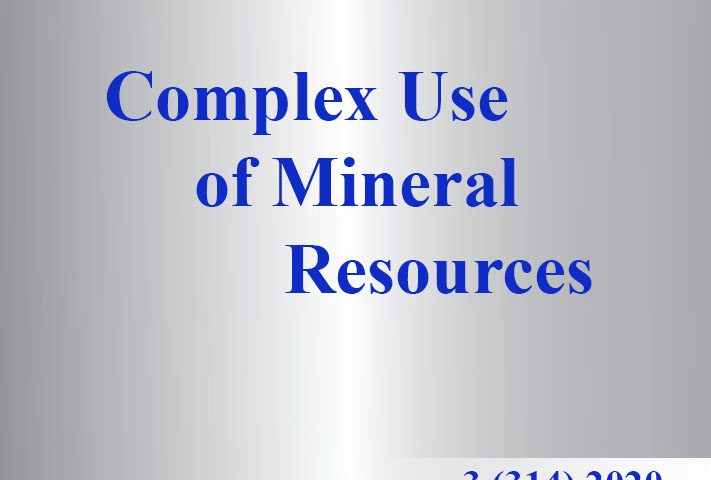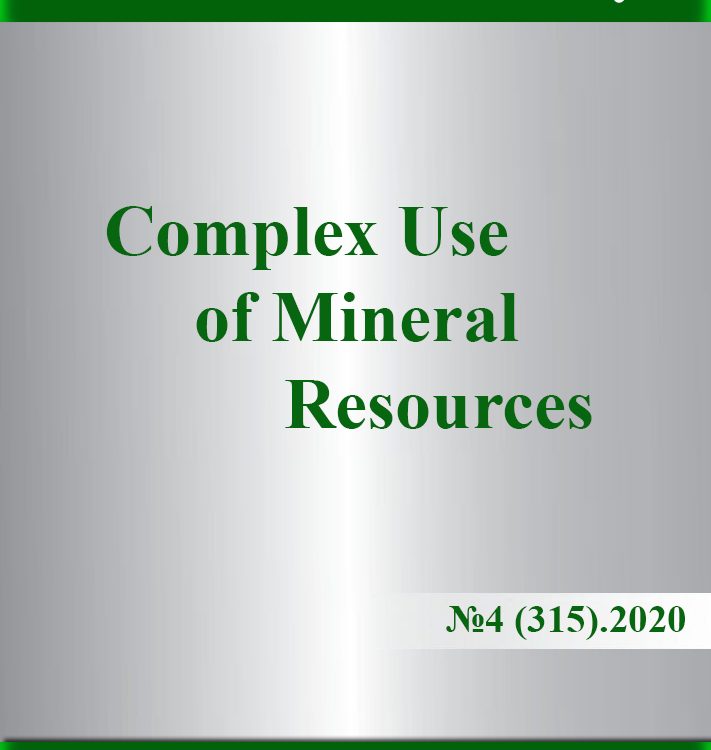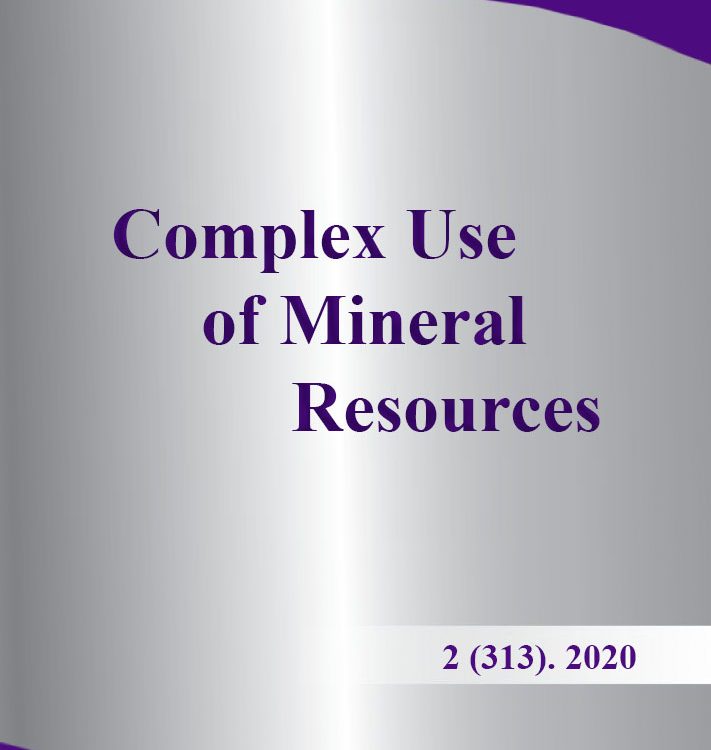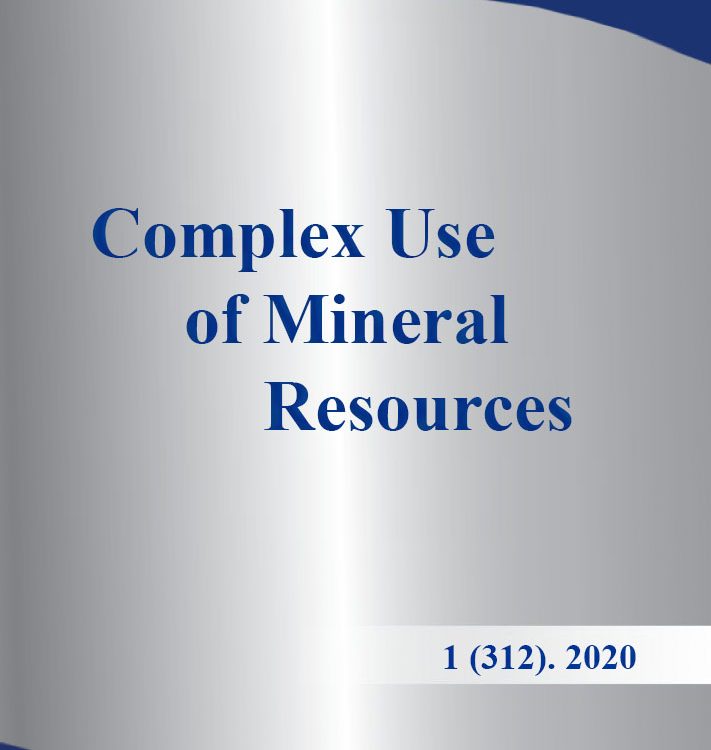Title: Converting of copper-lead matte: loss of gold and silver with slag
Authors: Dosmukhamedov N. K., Argyn A. A., Zholdasbay Е. Е., Kurmanseitov M. B.
Abstract: Based on comprehensive studies, including methods of elemental, X-ray phase analysis and mineralogical studies of solid slag and dust samples, quantitative ratios of the forms of finding copper, lead and precious metals are determined, a mechanism for the distribution of gold and silver between converting products is established. It is shown that the loss of gold and silver under the conditions of converting of copper-lead matte is associated with their redistribution between converter slag and dust. It was established that the loss of gold with converter slag and dust is determined by the content of mechanical losses of copper in them. Loss of silver in the slag is determined by the content of lead in them. As a result of mathematical processing of the compositions of the converting products, the regression equation of pair correlation is constructed, which describes the dependence of the gold loss in slag on the mechanical loss of copper in it with a high correlation coefficient (r = 0.92). An increase in mechanical losses of copper in slag from 0.5 to 0.95% leads to an increase in the gold content in slag by more than 1.5 times. An increase in the copper content in the form of sulfide in dust from 1.5 to 3% increases the gold content in dust from 2 to 7%. Unlike gold, silver is highly correlated with lead. An increase in the content of lead in slag from 17 to 25% increases the silver content in it from 100 to 150 g / t. It is shown that in the process of converting copper-lead matte, it is necessary to provide measures to minimize losses of copper and lead in slag, which will reduce the gold and silver contents in them and significantly increase their extraction into blister copper. To reduce the loss of gold, a solution is necessary on the one hand, the task of reducing the mechanical loss of copper with slag, and on the other, minimizing dust removal under conditions of converting copper-lead mattes.
Title: A mathematical model for determining the influence of factors on the stability of pillars and cameras
Authors: Tutanov S. K., Tutanov M. S., Tutanova M. S.
Abstract: This article presents the results of the research in determining the parameters of the stress-strain state of the rock mass around pillars, cameras and factors, which affect their stability. The vertical section of cirque around the ledges is considered as well. A flat deformed rectangular plane is divided by triangle grid with a corresponding boundary. Boundary conditions are chosen as a calculation scheme. A multidimensional mathematical model of the pit sides stability was obtained from the geological and mining factors. From the obtained formula for a multidimensional model, we can determine the factors that affect the stability of pillars and cameras. The resulting ratio makes it possible to determine the desired value.
Title: Study of the process of rhenium extraction from lead slime
Authors: Berdikulova F. A., Ikhlasova A. T.
Abstract: This article studies the oxidative firing process of lead sludge of copper production for the purpose of extracting rhenium. As an oxidizer, calcium hypochlorite is used, which is simultaneously an oxidizer of low-valent rhenium compounds and a binding reagent of rhenium oxides to calcium perrenate. Optimal conditions for the firing process are found: the firing temperature is 500-600°C, the firing duration is 30-60 minutes, and the oxidizer consumption is 20-40 % of the sludge mass. As a result of thermal studies and experimental work, it was established that the rhenium oxidation process begins at 180-260 °C after the decomposition of calcium hypochlorite and completely ends at 500-600 °C with the formation of calcium perrenate. During water leaching of the stub under the following conditions: T: W=1: 3, temperature of 70 °C, duration of 60 minutes, a solution containing 546 mg/l of rhenium was obtained. The degree of rhenium recovery in the solution was 93-94 %.
Title: Research of hydrometallurgical method of leaching gold from flotation tails with using bio-oxidation
Authors: Koizhanova A. K., Toktar G., Craig E. Banks., Magomedov D. R., Kubaizhanov A. A.
Abstract: This paper shows the results of the comparative study of the efficiency of gold extraction methods from technogenic flotation tails by agitation cyanidation and biooxidation followed by leaching. A representative sample of flotation tails was taken at gold extraction plant of Altyntau Kokshetau LLP. It was established that in the test sample contains 0.47 g / t Au and 0.62 g / t Ag. The gold extraction degree from flotation tailings with 80% content of 0.071 mm fraction was 50%, and that with 90% content of 0.071 mm fraction was 60%. Gold extraction plant's flotation tailings grinded to 0-0.044 mm fraction with sodium peroxide were subjected to pre-oxidation. The gold extraction degree from flotation tailings with 90% content of 0.044mm fraction at a solid-liquid ratio of 1:4 and a cyanide concentration of 1 g/dm3 is 65.2%. By using an active strain of thionic cultures the gold extraction degree was 72.1%.
Title: On the issue of minimizing carbon dioxide emissions into the atmosphere during the processing of industrial waste
Authors: Dikhanbaev B.I., Dikhanbaev A. B.
Abstract: The industrial activity of mankind using mineral raw materials and fossil fuels is steadily increasing man-made waste and carbon dioxide emissions. These factors, in turn, lead to pollution of the soil, air and an increase in the temperature of the earth’s atmosphere. This article discusses an example of waste-free processing of excavated slag and the search for a method of minimizing carbon dioxide in the exhaust gases of the smelting unit. When solving this problem, the main provisions of the method of extreme energy saving were used: 1) selection of a high-performance melting unit; 2) the formation of a technology that allows decreasing carbon dioxide emissions into the atmosphere; 3) development of a heating scheme for an energy-saving, waste-free, environmentally friendly processing of industrial waste. On the basis of the created energy-saving unit “reactor inversion phase – rotary kiln”, a thermal scheme for waste-free processing of zinc-containing slag has been developed. It is proposed that “CO2, H2O” in the reactor exhaust gas be reduced with zinc vapors to “CO, H2”. The resulting excess hydrogen will be used to displace from CO elemental carbon, which will serve as reducing agent in the zinc distiller. In case of implementation, the proposed system expects integrated waste management, minimization of CO2 emissions into the atmosphere up to 50% and a five-fold reduction in the specific fuel consumption per process.
Title: Extraction of copper from pregnant leaching solutions of lead dusts by liquid extraction
Authors: Altaibayev B. T., Khabiyev A.T., Baigenzhenov O.S., Bulenbayev M. Zh., Turan M.D.
Abstract: This paper presents the results of studies of intermediate processing for liquid extraction and re-extraction of copper from sulfate solutions obtained during agitation sulfuric acid leaching of lead dusts, which are technogenic wastes of the Zhezkazgan copper smelter and contain valuable components: more than 38 % lead, 2.4 % iron, 3 % zinc, 3.5% copper, 0.7 % arsenic, etc. The utilization of them can provide additional commercial products and improve the ecological environment of the area where they are located. The article also presents the results of the material balance of the processes of liquid extraction and copper re-extraction.
Title: Testing of the modified reagent during the dressing of oxidized copper ore in the enlarged laboratory conditions
Authors: Oskembekov I. M., Burkitseterkyzy G., Akubaeva M. А., Gizatullina D. R., Zhunussov E. M.
Abstract: In connection with the depletion of the ore base of the copper industry, there is a question of replenishing raw materials. In this regard, the involvement of oxidized copper ores in the processing is an urgent task. The paper presents the results of testing on an enlarged laboratory scale of the technology of flotation beneficiation of oxidized copper ore in the Balkhash region, based on preliminary sulfidization of the ore with a modified reagent. Research has been carried out to study the kinetics of the main, control and cleaning operations of oxidized copper ore flotation. Based on the data obtained, graphs of the dependence of copper extraction on the duration of operations were constructed. It has been established that preliminary sulfidization of ore with a modified reagent at its consumption of 20% of the stoichiometrically required amount makes it possible to obtain a commercial flotation copper concentrate with a content of 21% and recovery of 85% of copper.
Title: Study of the stability of the emulsion of ultramicroheterogeneous flotation reagents obtained by the method of ultrasonic dispersion
Authors: Yessengaziyev A. M., Barmenshinova M. B., Bilyalova S. M., Mukhanova A. A., Muhamedilova А. М.
Abstract: The results of studies of the stability of the microemulsion of an ultramicroheterogeneous flotation reagent obtained from a mixture of oil from the Zhanazhol field and butyl xanthate (BX) in the following ratios are presented: oil: BX = 1: 1; oil: BX = 2: 1; oil: BX = 4: 1. It was found that the microemulsion has the greatest stability when the ratio of oil: BX = 4: 1, which was 99.3% after 120 hours of exposure. The supposed emulsifying effect of butyl xanthate in symbiosis with natural emulsifiers of the oil itself over newly formed globules of ultrasonic (US) dispersion was found. At an ultrasonic treatment power of 250 W for 10 min, a microemulsion with an average globule size of 123.4 nm was obtained. It is shown that an increase in the duration of ultrasonic treatment for more than 10 minutes does not have a significant effect on the stability of the obtained microemulsion of an ultramicroheterogeneous reagent.
Title: Obtaining hydroxyapatite coatings by mechanochemical interaction
Authors: Mamaeva А. А., Kenzhegulov А. K., Panichkin А. V., Shah A.
Abstract: The research represents a newly-developed simple method to apply hydroxyapatite by gas-dynamic spraying. The hydroxyapatite coating formed on VT1-0 titanium were obtained following the mechanochemical interaction of hydroxyapatite and titanium with gas-dynamic spraying. The article proposes the phase composition, surface morphology, and roughness of these coatings. The surface morphology of the hydroxyapatite coating had a porous structure. The transverse sections of coatings were researched to study the interaction of hydroxyapatite with a titanium base. It was shown that the coatings mainly form in the titanium bedding depressions. Analyzing the roughness parameter Ra of hydroxyapatite coatings made it possible to conclude that the samples obtained fell almost within the same limits. These data are within the roughness optimum (Ra = 2-3 μm) of artificial surfaces aimed to manifest the best human osteogenic properties. The analyzed phase composition enabled to establish the fact that the hydroxyapatite layer composition does not change significantly after spraying that is important for biomedical use.
Title: Uranium extraction with modified sorbents
Authors: Abdikerim B.E., Kenzhaliyev B.K., Surkova T.Yu., Didik N., Berkinbayeva A.N., Dosymbayeva Z.D., Umirbekova N.S.
Abstract: Hydrometallurgical processing of uranium-containing raw materials generates a significant amount of liquid industry-related waste, namely waste solutions that require disposal. Sorption is known as one of the most effective methods for purifying liquid matters contaminated with radionuclides. Various modification options are being developed for the purpose of using natural sorbents and increasing their sorption capacity. The authors proposed the methods for modifying natural aluminosilicate and coal-mineral raw materials. Zeolite found at the Kusmurun deposit and shungite from the Koksu deposit were selected for the research. The methods are based on obtaining solid-phase extractants. It was proposed to modify natural sorbents with a mixture of tributyl phosphate and di2-ethylhexyl phosphoric acid in kerosene, as well as a mixture of phosphoric acid and polyacrylamide. It was demonstrated that the first method is preferable for zeolite, and the second one for shungite. The research addressed the sorption properties of modified sorbents in static and dynamic modes. Uranium sorption isotherms were plotted. The maximum sorption capacity and the Langmuir constant were calculated. The research allowed synthesizing an organopolymer based on shungite, glycidyl methacrylate, orthophosphoric, and hydroxyethyl diphosphoric acids. Its sorption properties were studied under dynamic conditions. Its sorption capacity was assessed in comparison with modified natural sorbents.





